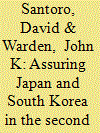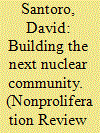|
|
|
Sort Order |
|
|
|
Items / Page
|
|
|
|
|
|
|
| Srl | Item |
| 1 |
ID:
143016


|
|
|
|
|
| Summary/Abstract |
Discussions about the requirements for U.S. extended deterrence and assurance are making a comeback. During the Cold War, U.S. analysts focused primarily on Western Europe, but in recent years the challenges of extended deterrence and assurance have been starker in Northeast Asia. Discussing the requirements for U.S. extended deterrence and assurance involves asking how the United States can deter its adversaries and assure its allies. In both cases, the critical factor is perception. According to analysts Clark Murdock and Jessica Yeats, “In the same way that deterrence must be tailored to each actor, situation, and form of warfare, assurance must be tailored to the strategic culture, threat perceptions, values, and specific concerns of each ally.”
|
|
|
|
|
|
|
|
|
|
|
|
|
|
|
|
| 2 |
ID:
162686


|
|
|
|
|
| Summary/Abstract |
This viewpoint takes stock of the changes in the strategic nuclear landscape in recent decades and reflects on its consequences on the policy community. It finds that the number and scope of issues have expanded considerably; they have manifested themselves in many more regions of the world; and they have become deeply politicized and polarized. The consequences have been twofold: the nuclear policy field has seen the development of an increasingly diverse expert community composed of highly specialized functionalists and regionalists, and it has become ever more divided into two entirely separate ideological camps—one that believes in deterrence, the other in disarmament. The stove-piping of expertise and the widening gap between deterrence and disarmament ideologies are immensely problematic because, in different ways, they stand in the way of the emergence of a better and safer nuclear future. Looking ahead, it is critical to “bust the silos of expertise” and to build bridges between the deterrence and disarmament ideological camps. Only such a community-building effort will help solve today’s and tomorrow’s nuclear challenges.
|
|
|
|
|
|
|
|
|
|
|
|
|
|
|
|
| 3 |
ID:
156359


|
|
|
|
|
| Summary/Abstract |
MAJOR-POWER competition is back. Russia’s annexation of Crimea, its subversive actions in eastern Ukraine, and its belligerent actions, rhetoric and nuclear signaling toward many European countries and the United States have forced members of the North Atlantic Treaty Organization (NATO) to refocus much of their activities on improving deterrence of Moscow. Similarly, China’s increasingly assertive actions in the East and South China Seas, and elsewhere, are driving the United States and its Asian allies to discuss ways to strengthen deterrence of Beijing. Over the past few years, a considerable amount of work has begun in Washington and beyond to find solutions to these important problems, because, while Russia and China are different actors (the former is a declining power and the latter a rising power), they are the only two states capable of challenging the United States militarily, both now and in the foreseeable future.
|
|
|
|
|
|
|
|
|
|
|
|
|
|
|
|
| 4 |
ID:
093557


|
|
|
|
|
| Publication |
2010.
|
| Summary/Abstract |
This special section examines the disarmament dynamics being generated by President Barack Obama and other world leaders in their advocacy of a nuclear-weapon-free world. It explores the responses of five groups of states (nuclear weapon states, threshold states, advocacy states, holdout states, and defiant states) to the new disarmament momentum, assessing whether a global consensus on-and concrete progress toward-nuclear elimination is likely. The main goals of this special section are: to generate scholarly debate on this important subject (the literature has tended to focus on understanding proliferation rather than disarmament dynamics); and to examine the potential consequences of reinvigorated disarmament leadership for the upcoming Review Conference of the Treaty on the Non-Proliferation of Nuclear Weapons, which will be held in New York City in May 2010.
|
|
|
|
|
|
|
|
|
|
|
|
|
|
|
|
| 5 |
ID:
093558


|
|
|
|
|
| Publication |
2010.
|
| Summary/Abstract |
The nuclear weapon states (NWS) have different perspectives on the desirability and feasibility of a world without nuclear weapons. A review of each of the current nuclear doctrines, postures, and disarmament policies of the five NWS shows that there is a clear divide between them, with some showing relatively determined leadership (the United States and the United Kingdom) and others expressing skepticism, if not complete disinterest (France, Russia, and China). Nevertheless, the prospects for progress on disarmament by the NWS at the 2010 Review Conference of the Treaty on the Non-Proliferation of Nuclear Weapons remain reasonably good. Yet complete success will require much time as well as sustained and applied efforts from the NWS, first and foremost to improve their performance as international security guarantors.
|
|
|
|
|
|
|
|
|
|
|
|
|
|
|
|
|
|
|
|
|